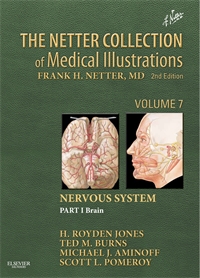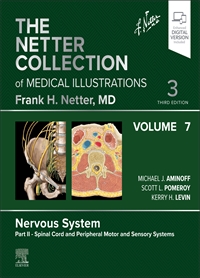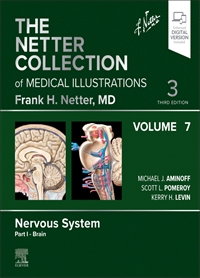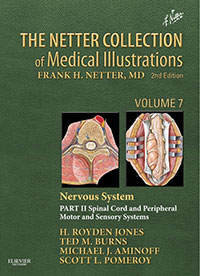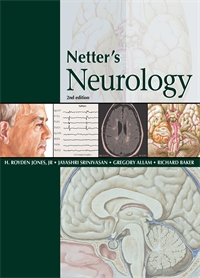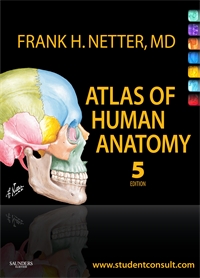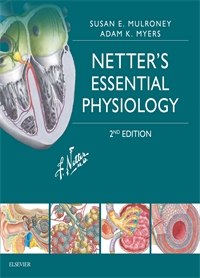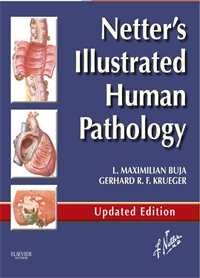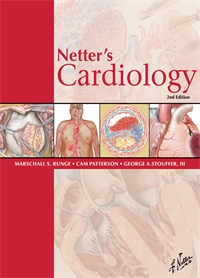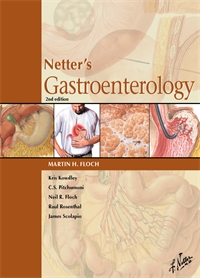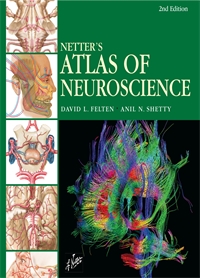Collectiion of Medical Illustrations, Nervous System, Volume 7 Part I, 2e
2nd Edition
Author: H. Royden Jones, Ted M. Burns, Michael J. Aminoff, Scott L. Pomeroy
ISBN: 9781416063872
- Page 2: Embryo at 18 Days
- Page 3: Embryo at 20 to 24 Days
- Page 4: Central Nervous System at 28 Days
- Page 5: Central Nervous System at 36 Days
- Page 6: Defective Neural Tube Formation
- Page 7: Defective Neural Tube Formation (Continued)
- Page 8: Spinal Dysraphism
- Page 9: Spinal Dysraphism (Continued)
- Page 10: Fetal Brain Growth in the First Trimester
- Page 11: Craniosynostosis
- Page 12: Extracranial Hemorrhage and Skull Fractures in the Newborn
- Page 13: Intracranial Hemorrhage and Skull Fractures in the Newborn
- Page 14: The External Development of the Brain in the Second and Third Trimesters
- Page 15: Mature Brain Ventricles
- Page 16: Hydrocephalus
- Page 17: Surgical Treatment of Hydrocephalus
- Page 18: Cerebral Palsy
- Page 19: Establishing Cellular Diversity in the Embryonic Brain and Spinal Cord
- Page 21: Generation of Neuronal Diversity in the Spinal Cord and Hindbrain
- Page 23: Circuit Formation in the Spinal Cord
- Page 24: Sheath and Satellite Cell Formation
- Page 25: Development of Myelination and Axon Ensheathment
- Page 26: Brachial Plexus and/or Cervical Nerve Root Injuries at Birth
- Page 27: Morphogenesis and Regional Differentiation of the Forebrain
- Page 28: Neurogenesis and Cell Migration in the Developing Neocortex
- Page 29: Neuronal Proliferation and Migration Disorders
- Page 30: Developmental Dyslexia
- Page 31: Autism Spectrum Disorders
- Page 32: Rett Syndrome
- Page 34: Superolateral Surface of Brain
- Page 35: Medial Surface of Brain
- Page 36: Inferior Surface of Brain
- Page 37: Cerebral Cortex: Function and Association Pathways
- Page 38: Major Cortical Association Bundles
- Page 39: Corticocortical and Subcorticocortical Projection Circuits
- Page 40: Corpus Callosum
- Page 41: Rhinencephalon and Limbic System
- Page 42: Hippocampus
- Page 43: Fornix
- Page 45: Forebrain Regions Associated with Hypothalamus
- Page 46: Thalamocortical Radiations
- Page 47: Neuronal Structure and Synapses
- Page 48: Chemical Synaptic Transmission
- Page 49: Summation of Excitation and Inhibition
- Page 50: Types of Neurons in Cerebral Cortex
- Page 51: Astrocytes
- Page 52: Testing for Defects of Higher Cortical Function
- Page 53: Memory Circuits
- Page 54: Amnesia
- Page 55: Dominant Hemisphere Language Dysfunction
- Page 56: Nondominant Hemisphere Higher Cortical Dysfunction
- Page 57: Alzheimer Disease: Pathology
- Page 58: Alzheimer Disease: Distribution of Pathology
- Page 59: Alzheimer Disease: Clinical Manifestations, Progressive Phases
- Page 60: Frontotemporal Dementia
- Page 61: Dementia with Lewy Bodies
- Page 62: Vascular Dementia
- Page 63: Treatable Dementias
- Page 64: Normal-Pressure Hydrocephalus
- Page 66: Electroencephalography
- Page 67: Focal (Partial) Seizures
- Page 68: Generalized Tonic-Clonic Seizures
- Page 69: Absence Seizures
- Page 70: Epileptic Syndromes
- Page 71: Neonatal Seizures
- Page 72: Status Epilepticus
- Page 74: Neurobiology of Epilepsy
- Page 75: Neurobiology of Epilepsy (Continued)
- Page 76: Neurobiology of Epilepsy (Continued)
- Page 77: Treatment of Epilepsy: Preoperative Evaluation
- Page 78: Treatment of Epilepsy: Resective Surgery
- Page 80: Limbic System
- Page 81: Major Depressive Disorder
- Page 82: Postpartum Depression
- Page 83: Bipolar Disorder
- Page 84: Generalized Anxiety Disorder
- Page 85: Social Anxiety Disorder
- Page 86: Panic Disorder
- Page 87: Posttraumatic Stress Disorder
- Page 88: Obsessive-Compulsive Disorder
- Page 89: Somatization
- Page 90: Conversion Disorder
- Page 91: Schizophrenia
- Page 92: Alcohol Use Disorders
- Page 93: Treatment for Alcohol Use Disorders
- Page 94: Alcohol Withdrawal
- Page 95: Opioid Use Disorders
- Page 96: Opioid Withdrawal
- Page 97: Borderline Personality Disorder
- Page 98: Antisocial Personality Disorder
- Page 99: Intimate Partner Abuse
- Page 100: Elder Abuse
- Page 101: Delirium and Acute Personality Changes
- Page 102: Delirium and Acute Personality Changes (Continued)
- Page 103: Insomnia
- Page 104: Pediatrics: Depressive Disorders
- Page 105: Pediatrics: Anxiety Disorders
- Page 106: Pediatrics: Disruptive Behavior Disorders
- Page 107: Pediatrics: Attention-Deficit/Hyperactivity Disorders
- Page 108: Pediatrics: Eating Disorders
- Page 109: Child Abuse: Fractures in Abused Children
- Page 110: Child Abuse: Staging of Injuries and Injury Patterns
- Page 112: Anatomic Relationships of the Hypothalamus
- Page 113: Development and Developmental Disorders of the Hypothalamus
- Page 114: Blood Supply of the Hypothalamus and ituitary Gland
- Page 115: General Topography of the Hypothalamus
- Page 116: Overview of Hypothalamic Nuclei
- Page 117: Hypothalamic Control of the Pituitary Gland
- Page 118: Hypothalamic Control of the Autonomic Nervous System
- Page 119: Olfactory Inputs to the Hypothalamus
- Page 120: Visual Inputs to the Hypothalamus
- Page 121: Somatosensory Inputs to the Hypothalamus
- Page 122: Taste and Other Visceral Sensory Inputs to the Hypothalamus
- Page 123: Limbic and Cortical Inputs to the Hypothalamus
- Page 124: Overview of Hypotthalamic Function and Dysfunction
- Page 125: Regulation of Water Balance
- Page 126: Temperature Regulation
- Page 127: Fever: Cytokines and Prostaglandins
- Page 128: Fever: Hypothalamic Responses During Inflammation Modulate Immune Response
- Page 129: Regulation of Food Intake, Body Weight, and Metabolism
- Page 130: Stress Response
- Page 131: Hypothalamic Regulation of Cardiovascular Function
- Page 132: Hypothalamic Regulation of Sleep
- Page 133: Narcolepsy: A Hypothalamic Sleep Disorder
- Page 134: Sleep-Disordered Breathing
- Page 135: Divisions of the Pituitary Gland and its relationships to the Hypothalamus
- Page 136: Divisions of the Pituitary Gland and its relationships to the Hypothalamus
- Page 137: Posterior Pituitary Gland
- Page 138: Anatomic Relationships of the Pituitary Gland
- Page 139: Effects of Pituitary Mass Lesions on the Visual Apparatus
- Page 140: Anterior Pituitary Hormone Deficiencies
- Page 141: Severe Anterior Pituitary Hormone Deficiencies (Panhypopituitarism)
- Page 142: Postpartum Pituitary Infarction (Sheehan Syndrome)
- Page 143: Pituitary Apoplexy
- Page 144: Thalamic Anatomy and Pathology
- Page 145: Thalamic Anatomy and Pathology (Continued)
- Page 148: Coma
- Page 149: Disorders of Consciousness
- Page 151: Prognosis in Coma Related to Severe Head Injuries
- Page 152: Differential Diagnosis of Coma
- Page 153: Hypoxic-Ischemic Brain Damage
- Page 154: Vegetative State and Minimally Conscious State
- Page 155: Brain Death
- Page 156: Ventilatory Patterns and the Apnea Test
- Page 158: Basal Nuclei (Ganglia)
- Page 159: Basal Ganglia and Related Structures
- Page 160: Schematic and Cross Section of Basal Ganglia
- Page 161: Parkinsonism: Early Manifestations
- Page 162: Parkinsonism: Successive Clinical Stages
- Page 163: Neuropathology of Parkinson Disease
- Page 164: Progressive Supranuclear Palsy
- Page 165: Corticobasal Degeneration
- Page 166: Parkinsonism: Hypothesized Role of Dopamine
- Page 167: Surgical Management of Movement Disorders
- Page 168: Hyperkinetic Movement Disorder: Idiopathic Torsion Dystonia
- Page 169: Hyperkinetic Movement Disorder: Cervical Dystonia
- Page 170: Chorea/Ballism
- Page 171: Tremor
- Page 172: Tics and Tourette Syndrome
- Page 173: Myoclonus
- Page 174: Wilson Disease
- Page 175: Psychogenic Movement Disorders
- Page 176: Cerebral Palsy
- Page 178: Cerebellum and the Fourth Ventricle
- Page 179: Cerebellum Gross Anatomy
- Page 180: Cerebellar Peduncles
- Page 181: Cerebellar Cortex and Nuclei
- Page 182: Cerebellar Cortex and Nuclei (Continued)
- Page 184: Cerebellar Cortical and Corticonuclear Circuitry (Continued)
- Page 185: Cerebellum Subdivisions and Afferent Pathways
- Page 186: Cerebellum Subdivisions and Afferent Pathways (Continued)
- Page 187: Cerebellar Efferent Pathways
- Page 189: Cerebellovestibular Pathways
- Page 190: Cerebellum Modular Organization
- Page 191: Cerebrocerebellar Connections
- Page 192: Cerebellar Motor Examination
- Page 193: Cerebellar Cognitive Affective Syndrome
- Page 194: Cerebellar Disorders Differential Diagnosis
- Page 195: Gait Disorders--Differential Diagnosis
- Page 196: Gait Disorders--Differential Diagnosis (Continued)
- Page 197: Friedreich Ataxia
- Page 200: Arteries to Brain and Meninges
- Page 201: Territories of the Cerebral Arteries
- Page 202: Arteries of Brain: Lateral and Medial Views
- Page 203: Arteries of Brain: Frontal View and Section
- Page 204: Stroke Subtypes
- Page 205: Temporal Profile of Transient Ischemic Attack (TIA) and Completed Infarction (Cl)
- Page 206: Clinical Evaluation and Therapeutic Options in Stroke
- Page 207: Clinical Evaluation and Therapeutic Options in Stroke (Continued)
- Page 208: Uncommon Etiologic Mechanisms in Stroke
- Page 209: Common Sites of Cerebrovascular Occlusive Disease
- Page 210: Other Etiologies of Carotid Artery Disease
- Page 211: Clinical Manifestations of Carotid Artery Disease
- Page 212: Occlusion of Middle and Anterior Cerebral Arteries
- Page 213: Diagnosis of Internal Carotid Disease
- Page 214: Diagnosis of Carotid Artery Disease
- Page 215: Carotid Endarterectomy
- Page 216: Endovascular ICA Angioplasty and Stenting Using A Protective Device
- Page 217: Arterial Distribution to the Brain: Basal View
- Page 218: Arteries of Posterior Cranial Fossa
- Page 219: Clinical Manifestations of Vertebrobasilar Territory Ischemia
- Page 220: Intracranial Occlusion of Vertebral Artery
- Page 221: Occlusion of Bassilar Artery and Branches
- Page 222: Occlusion of ""Top of Basilar"" and Posterior Cerebral Arteries
- Page 223: Cardiac Sources of Brain Emboli
- Page 224: Uncommon Cardiac Mechanisms In Stroke
- Page 225: Lacunar Infarction
- Page 226: Risk Factors for Cardiovascular Disease
- Page 227: Hypertensive Encephalopathy
- Page 228: Hypoxia
- Page 229: Role of Platelets in Arterial Thrombosis
- Page 230: Inherited Thrombophilias
- Page 231: Antiphospholipid Antibody Syndrome
- Page 232: Meninges and Superficial Cerebral Veins
- Page 233: Intracranial Venous Sinuses
- Page 234: Diagnosis of Venous Sinus Thrombosis
- Page 235: Pathogenesis and Types
- Page 236: Clinical Manifestations of Intracranial Hemorrhage Related to Site
- Page 237: Vascular Malformations
- Page 238: Distribution and Clinical Manifestations of Congenital Aneurysm Rupture
- Page 239: Giant Congenital Aneurysms
- Page 240: Opthalmologic Manifestations of Cerebral Aneurysms
- Page 241: Ophthalmologic Manifestations of Cerebral Aneurysms
- Page 242: Interventional Radiologic Repair of Berry Aneurysms
- Page 243: Pediatric Cerebrovascular Disease
- Page 244: Positioning in Bed and Passive Range-of-Motion Exercises After Stroke
- Page 245: Aphasia Rehabilitation
- Page 246: Other Rehabilitative Issues: Dysphagia/Gait Training/Locked-in Syndrome
- Page 248: Multiple Sclerosis: Overview
- Page 249: Clinical Manifestations
- Page 250: Diagnosis: MRI in Multiple Diagnosis
- Page 251: Diagnosis: Spinal Cord MRI in Multiple Sclerosis
- Page 252: Diagnosis: Spinal Cord MRI in Multiple Sclerosis
- Page 253: MS Pathophysiology
- Page 254: MS Pathophysiology (Continued)
- Page 256: MS Relapses
- Page 257: MS Relapses (Continued)
- Page 258: MS Relapses (Continued)
- Page 259: MS Relapses: Consequences
- Page 260: Enigma of Progressive MS
- Page 261: MS Pathology
- Page 262: MS Treatment
- Page 264: Neuromyelitis Optica, Acute Disseminated Encephalomyelitis, and Acute Hemorrhagic Leukoencephalitis Вadiologic Findings
- Page 265: Neuromyelitis Optica, Acute Disseminated Encephalomyelitis, and Acute Hemorrhagic LeukoencephalitisЈistopathologic Findings
- Page 266: Other Neuroimmunologic Syndromes: An Overlap Between Primary and Paraneoplastic Processes
- Page 267: Stiff-Man Syndrome
- Page 268: Paraneoplastic Immune-Mediated Disorders
- Page 269: Paraneoplastic Immune-Mediated Disorders
- Page 270: Neuroimmunology: Paraneoplastic and Other Autoimmune SyndromesЃentral Nervous System
- Page 271: Neuroimmunology: Paraneoplastic and Other Autoimmune SyndromesАeripheral Motor Sensory Unit
- Page 274: Bacterial Meningitis
- Page 275: Bacterial Meningitis (Continued)
- Page 276: Brain Abscess
- Page 277: Parameningeal Infections
- Page 278: Infections in the Immunocompromised Host: Progressive Multifocal Leukoencephalopathy and Nocardiosis
- Page 279: Infections in the Immunocompromised Host: Listeriosis and Toxoplasmosis
- Page 280: Neurocysticercosis
- Page 281: Spirochetal Infections: Neurosyphilis
- Page 282: Spirochetal Infections: Lyme Disease
- Page 283: Tuberculosis of Brain and Spine
- Page 284: Tetanus
- Page 285: Aseptic Meningitis
- Page 286: Primary HIV Infection of the Nervous System
- Page 287: HIV Life Cycle and Antiretroviral Medications
- Page 288: Poliomyelitis
- Page 289: Herpes Zoster
- Page 290: Herpes Simplex Virus Encephalitis and Rabies
- Page 292: Trichinosis (Trichinellosis)
- Page 293: Cryptococcal Meningitis
- Page 294: Creutzfeldt-Jakob Disease
- Page 295: Neurosarcoidosis
- Page 298: Clinical Presentations of Brain Tumors
- Page 299: Gliomas
- Page 300: Glioblastoma
- Page 301: Pediatric Brain Tumors
- Page 302: Pediatric Brain Tumors (Continued)
- Page 303: Metastatic Tumors to Brain
- Page 304: Meningiomas
- Page 305: Meningiomas (Continued)
- Page 306: Pituitary Tumors
- Page 307: Clinically Nonfunctioning Pituitary Tumor
- Page 308: Craniopharyngioma
- Page 309: Tumors of Pineal Region
- Page 310: Vestibular Schwannomas
- Page 311: Removal of Vestibular Schwannomas
- Page 312: Intraventricular Tumors
- Page 313: Chordomas
- Page 314: Differential Diagnosis of CNS Tumors
- Page 315: Treatment Modalities
- Page 318: Overview of Headaches
- Page 319: Migraine Pathophysiology
- Page 320: Migraine Presentation
- Page 321: Migraine Aura
- Page 322: Migraine Management
- Page 323: Trigeminal Autonomic Cephalagias: Cluster Headache
- Page 324: Trigeminal Autonomic Cephalagias: Paroxysmal Hemicrania (PH)
- Page 325: Tension-Type Headache and Other Benign Episodic and Chronic Headaches
- Page 326: Pediatric Headache
- Page 327: Cranial NeuralgiasДrigeminal Neuralgia
- Page 328: Other Cranial Neuralgias
- Page 329: Idiopathac Intracranial Hypertension (IIH), Pseudotumor Cerebri
- Page 330: Intracranial Hypotension/ Low Cerebrospinal Fluid Pressure Headache
- Page 331: Giant Cell Arteritis
- Page 332: Contiguous Structure Headaches
- Page 333: Thunderclap Headache and Other Headaches Presenting in the Emergency Department
- Page 334: Headaches Presenting in the Emergency Department (Continued)
- Page 335: Headaches Presenting in the Emergency Department (Continued)
- Page 336: Headaches Presenting in the Emergency Department (Continued)
- Page 338: Skull: Anterior View
- Page 339: Skull: Lateral View
- Page 340: Skull: Madisagittal Section
- Page 341: Calvaria
- Page 342: External Aspect of Skull Base
- Page 343: Internal Aspects of Base of Skull: Bones
- Page 344: Internal Aspects of Base of Skull: Orifices
- Page 345: Skull Injuries
- Page 346: Concussion
- Page 347: Acute Epidural Hematoma
- Page 348: Acute Subdural Hematoma
- Page 349: CT Scans and MR Images of Intracranial Hematoma
- Page 350: Vascular Injury
- Page 351: Initial Assessment and Management of Head Injury
- Page 352: Glasgow Coma Score
- Page 353: Devices for Monitoring Intracranial Pressure
- Page 354: Neurocritical Care and Management: Decompressive Craniectomy
